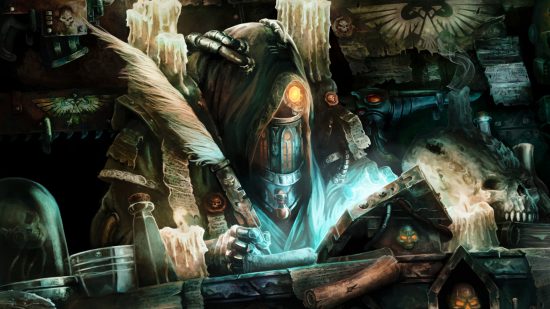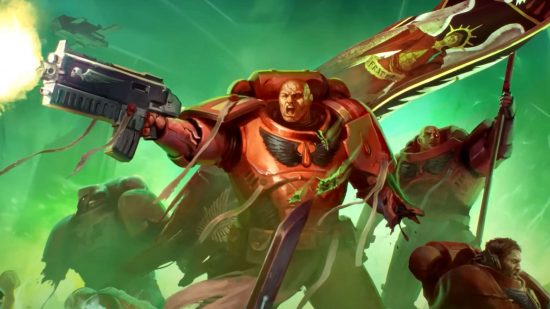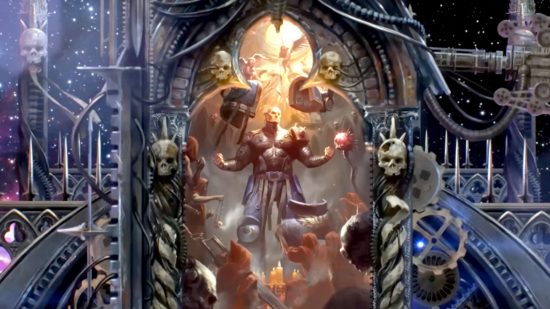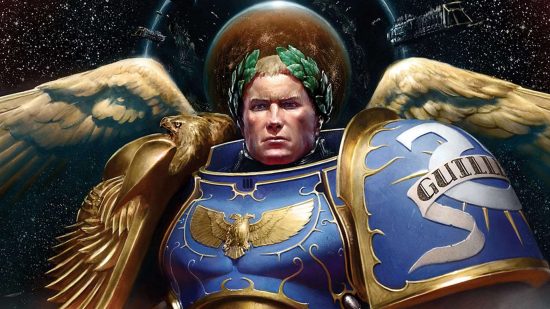The Space Marines Codex Astartes is a combination of a strategic manual, military operations primer, and religious text. Written by the Ultramarines Primarch Roboute Guilliman in the aftermath of the Horus Heresy civil war, this sacred tome set the template for how Space Marines would make war for the next ten thousand years
This guide dives deep into one corner of Warhammer 40k lore. We have a separate guide that gives a general overview of the Space Marines, and another that shows the differences among the many Space Marine chapters and how they interpret the Codex, which are a great place to start if you’re fairly new to the setting.
Here’s everything you need to know about the Space Marines Codex Astartes:
What is the Codex Astartes?
The Codex Astartes is an organisational and tactical manual that dictates the composition, operation, and tactical doctrines of Space Marine Chapters. Roboute Guilliman, Primarch of the Ultramarines, wrote the Codex Astartes shortly after the Horus Heresy, and it has remained in use for ten millennia since.
The Codex dictates that a Space Marine Chapter contains no more than 1,000 battle brothers, plus support staff and specialists. These must be divided between a veteran first company, four battle companies, three reserve companies, and a neophyte scout company. It specifies standards for wargear, standards for recruitment, even recommended squad markings for different battlefield roles, and contains a wealth of strategic insight.

Not every Chapter follows the Codex Astartes with equal dedication. Some chapters treat the Codex Astartes with the reverence of a holy text, others consider it more as “guidelines”, and some – such as the Space Wolves – think that it makes passable toilet paper. Even among Chapters that follow the Codex Astartes to the letter, interpretations vary greatly, changed by the long march of time.
Adherence to the Codex is no guarantee against treachery. The disgraced (and long-since disbanded) Fists Exemplar chapter were such staunch adherents of the Codex Astartes that they revered Guilliman almost as much as their own genefather Rogal Dorn. Their pride and self-satisfaction that they were masters of the ideal form of war led them into disgrace during the War of the Beast – you can learn more about them in The Beast Arises series, starting with book six, ‘Echoes of the Long War’.
Origins of the Codex Astartes
In the aftermath of the Horus Heresy civil war, Guilliman assumed the mantle of Imperial Regent and Lord Commander of the Imperium. One of his most significant political reforms was to mandate the surviving Space Marine Legions be broken into self-sufficient Chapters of 1,000 battle brothers, organised according to the Codex Astartes.
This, and further reforms like the removal of Space Marines from conventional Imperial military hierarchies, were intended to ensure no single warrior could again wield the power and influence of the traitor Warmaster. As the commander of the largest surviving Space Marine Legion, it was probably also a necessary political gesture for Guilliman to prevent accusations that he was positioned to take full control of the Imperium.
Guilliman first began to write the strategic and tactical doctrines found in the Codex Astartes during the Horus Heresy, after the World Eaters surprise attack stranded him and his legion in the realm of Ultramar away from the main war. You can learn more about the events warfare that inspired Guilliman to write the Codex in the short story Red-Marked, collected in Horus Heresy book 35, Eye of Terra.

Changes to the Codex Astartes
Over the millennia since Guilliman’s original decree, volumes of the Codex Astartes have been hand-copied by scribes millions upon millions of times. Each lineage of books has accumulated errors, omissions, insertions, fabrications, and marginalia. Early, accurate editions of the text have been lost in wars, fires, and cataloguing errors – forgeries and heretical fabrications have been circulated.
The biggest changes of all came following the opening of the Cicatrix Maledictum and the resurrection of Roboute Guilliman. After making the journey from Macragge to Terra with the Adeptus Mechanicus Archmagos Belisarius Cawl, Guilliman revealed the Ultima founding; a secret cache of tens of thousands of superior Primaris Space Marines with troves of new wargear.

This bounty of new warriors and new materiel required substantial revisions to the Codex Astartes. Primaris reinforcements have been accepted by Space Marine chapters, gratefully or grudgingly, and most have accepted the reformed Codex Astartes as well.
Despite the dire straits the Imperium finds itself in, Guilliman has not relaxed the stipulation that Space Marine Chapters are limited to 1,000 Battle Brothers – though there’s no sign that he intends to enforce this limit on chapters like the Black Templars. Neither has this limit prevented him from commanding the “Unnumbered Sons” during the Indomitus Crusade, tens of thousands of Primaris Space Marines yet to be assigned to a parent Chapter.
If you’re a big fan of military logistics, make sure you check out our guides to the best grand strategy games and best 4X games. If you, like us, enjoy the bureaucratic side of Warhammer 40k lore, we heartily recommend the Warhammer 40k RPG Imperium Maledictum – yes you can play as Inquisitorial acolytes or Astra Militarum veterans, but Wargamer had a hoot playing as tax auditors.


